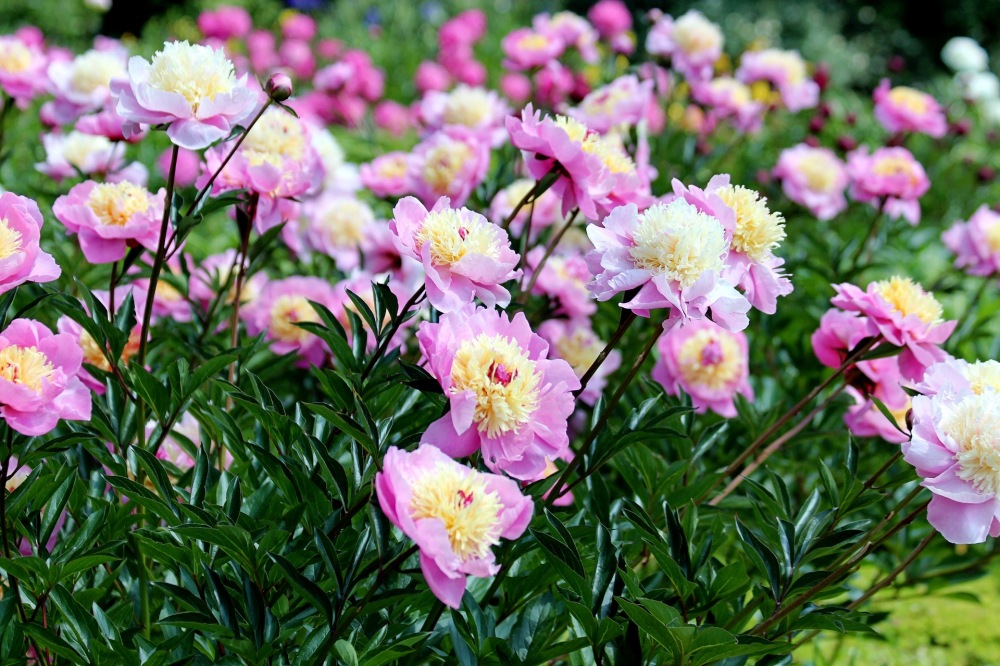
From Bud to Bloom: How to Plant, Grow, and Care for Stunning Peonies in Your Garden
The Almanac Garden Planner - Use It Free for 7 Days!
Plan your 2025 garden with our award-winning Garden Planner.
Types
In the 1930s and 1940s, plant catalogs listed only three peony choices: white, crimson, and rose pink. Today, thousands of varieties are available.
There are six main peony flower types: anemone, single, Japanese, semidouble, double, and bomb. Fragrances vary as well—some plants, such as ‘Festiva Maxima’ and ‘Duchesse de Nemours’, have intoxicating rose-like scents, while others are lemony or have no scent at all.

Peonies bloom between late spring and early summer, but you can plan your garden for a successive display of flowers from mid-May to late June by planting various varieties. Here are some choices:
- Anemone (an advanced Japanese form)—‘Laura Dessert’: cream/pale lemon to white; strong fragrance; early-season
- Single (one row of petals)—‘Sparkling Star’: deep pink; early- to midseason
- Japanese (decorative centers)—‘Carrara’: white, with soft yellow centers; fragrant; midseason
- Semidouble (five or more guard petals and prominent centers)—‘Pink Hawaiian Coral’: pink to coral rose form; slight fragrance; early-season
- Double (large petals, needs support)—‘Candy Stripe’: white, with red streaks; slight fragrance; mid- to late-season
- Bomb (large, like a scoop of petals)—‘Angel Cheeks’: soft pink; slight fragrance; midseason
- Consider, too, the Itoh peony: Named after its developer, Japanese botanist Dr. Toichi Itoh (d. 1956), this flower is a cross between a herbaceous (bush) peony and a tree peony. Its large single, semidouble, and double blooms appear later in the season and last longer than traditional peonies.
ADVERTISEMENT
Yes, the whole thing goes into the soil. Find the little “eyes”—something like potato “eyes:—they should face up, be on the “up” side.The tube should be placed in/on the soil almost horizontally; the tuber does not get planted “the long way”—it should pretty much lay on its side. And yes, you’re right_planted 1 to 2 inches deep.
I have some peonies that I planted a few years ago. The first year was a drought year, and they died. Or so i thought. After a year or two of more moisture, they began to grow. I was amazed, and figured they must have gone dormant and now would grow nicely. Not so. Some are nice and bushy, but others have one or two tiny stalks. Is there any way to save these "resurrected" peonies? Should I dig them up and try again, in case they are too deep?
So some are thriving? It is amazing! Although generally speaking, peonies are pretty drought resistant (at least, that’s the thinking). You could check the depth of the weaker ones with the tiny stalks, and while you’re at it check their overall condition. If there is damage or any signs of disease (rot) or dryness and discard, if necessary. Fall is the best time to do this.
Overall, you might also check your soil pH; peonies like 6.5 to 7.0. See here for more on that: http://www.almanac.com/content/ph-preferences
You might also just reconsider the growing conditions: soil quality, sunlight, moisture. Above, we advise low to no fertilizer, but if you want to give your plants a boost, a “complete” fertilizer (5-10-5 or 5-10-10) at 2 to 3 ponds per 100 square feet in the spring (or very soon) would be ok. So would, alternatively, an inch or so of aged manure.
If these steps fail to bring the wee ones back to thriving condition by next year, then you should think about replacing them—in which case before you spend any money, you could see if the existing plants can/should be divided.
We hope this helps.
Can peonies be grown in pots if there deep enough?
A large group of peonies were thriving when we bought our house in N Central NJ 10 years ago. Now some seem to be failing - some of the smaller plants have simply disappeared, the larger ones are much less full than in past years. We had a weird warm spell in January where many flowers came up and were on the verge of blooming, then another cold snap. Could this have stunted the peonies? What can I do to bring them back to health?
It’s not clear: did your peonies come up in January? Or did “many other flowers”? That would be a pretty warm spell!
Based on your comment that the peonies are failing, we will suggest that some viruses may stunt and/or deform the growth and cause steady decline. Your best bet would be to replace them with new plants. However, before you do that, you might also take a picture and put the question to a nursery person near you. And ask if it is safe to replant in the same soil. (We can not get a straight answer on that point.)
My neighbor has peonies that I have admired and even been able to enjoy in my home. So I was wondering if using some of those pods would grow some more peonies?
How would I go about it though? I'm thinking there are seeds in there???
there comes a time when peonies require thinning. This is when you can or should collect the ROOTS for starting your own bed of flowers.
I purchased three tubers and planted in the fall as recommended. I get leaves but no flowers. One of the plants had two or three flowers the first spring, but last year and this year I just get the plant with loses of leaves. The other two never bloomed. This is the third spring since planting. What can I do to get flowers? I live in Michigan.
My peony plants, about 12 years old, are doing poorly, and the roots are coming to the surface. My guess is it is because there is a Japanese Maple tree planted nearby, and it is sucking up too many nutrients, and pushing the peony roots up?













